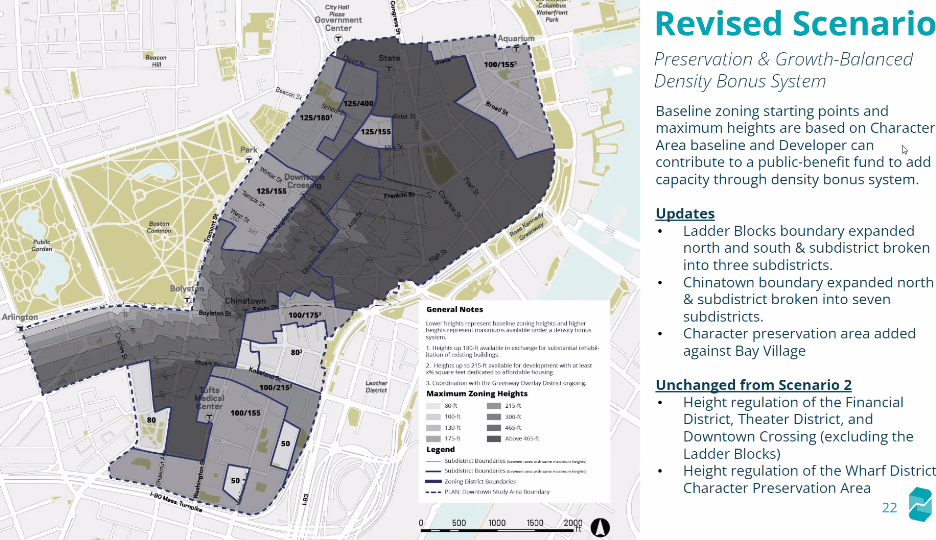- Joined
- Dec 10, 2011
- Messages
- 5,599
- Reaction score
- 2,717
I'm unlocking this thread. Let's start by not re-hashing arguments, but by posting useful links.
In the XMBLY thread, we touched on height (and probably fanned the flames), so I'm re-opening this thread, in the hopes that we can constructively engage. (If we can't, mods will lock it again).
In the XMBLY thread, I introduced, without evidence, the reasons why Somerville might want to only allow 250' worth of building in a space where the FAA would permit 500. Here I'm going to stack them up and give them links.
Here are some natural "step function" points:
- 260' = 25 stories a [construction-cost] break-point reported by Glaeser in NYC
- 208' = (20 stories) the height at which energy use per square foot is fully double that of buildings of 5 stories or shorter.
- 158' = (15 Stories) a [construction-cost] break point reported by Glaeser in NYC
- 137' = The height of north america's tallest Aerial Ladder Firetruck. In Somerville, where the first floors are 18' and uppers are at least 10', an 13-storey building would be 128' tall.
- 108' = (10 stories) the height above which a service elevator is recommended
- 70' = The height at which a building is considered "high rise" in Mass (many safety costs start here)
- 75' = of elevator travel requires elevator lobbies or smoke doors or elevator pressurization
- 70' = Six Story mid rise a break-point in price reported by Glaeser
- 40' = The most energy-efficient height for a building (minimizes energy in lifting, minimizes surface area to building volume heat gain/loss)
- 40' = (4 stories) the height at which "gurney sized" elevators are needed (so firefighters can carry a sick person down)
Other Breakpoints I'd like to better understand
- Typical "Second Bank of Elevators" height. Breaking elevators into 1-12 and 14-22 etc. happens at different points, but there is going to be some point at which the "high people" demand it.
- Typical "Fourth Elevator" Height. Seems determined by a mix of "how many units are served by this bank of elevators" (some say 1 elevator per 90 units). At some point you've maxed your 3 elevators and adding one more floor's worth of units triggers the need for a 4th elevator
- Typical "Third Elevator" Height. Seems determined by a mix of "how many units are served by this bank of elevators" (some say 1 elevator per 90 units). At some point you've maxed your 2 elevators and adding one more floor's worth of units triggers the need for a 3rdelevator
- 200 unit price break point (while costs per unit are fairly constant between 20 and 200 units, there's a step at 200. I suspect this is where the "3rd elevator" break is. (see Table 1)
- Utility line losses (if there's a central source of steam or chilling, at what point do the efficiencies of scale get lost to the inefficiency of pipes
- Utility piping cost, space wasted on vertical shafts and lifting water. Every new set of units added to the top of a building increases the diameter / cross section of the pipes needed to raise the gas or water (or take the sewer)
- Streetwall: you can activate more street with more-but-shorter buildings (ask Paris)
- Tenant preference: Nobody likes long elevator waits nor long elevator rides.
Bibliography:

 buildingandinteriors.com
buildingandinteriors.com
 e-one-aerials.com
e-one-aerials.com

 e-one-aerials.com
e-one-aerials.com
In the XMBLY thread, we touched on height (and probably fanned the flames), so I'm re-opening this thread, in the hopes that we can constructively engage. (If we can't, mods will lock it again).
In the XMBLY thread, I introduced, without evidence, the reasons why Somerville might want to only allow 250' worth of building in a space where the FAA would permit 500. Here I'm going to stack them up and give them links.
Here are some natural "step function" points:
- 260' = 25 stories a [construction-cost] break-point reported by Glaeser in NYC
- 208' = (20 stories) the height at which energy use per square foot is fully double that of buildings of 5 stories or shorter.
- 158' = (15 Stories) a [construction-cost] break point reported by Glaeser in NYC
- 137' = The height of north america's tallest Aerial Ladder Firetruck. In Somerville, where the first floors are 18' and uppers are at least 10', an 13-storey building would be 128' tall.
- 108' = (10 stories) the height above which a service elevator is recommended
- 70' = The height at which a building is considered "high rise" in Mass (many safety costs start here)
- 75' = of elevator travel requires elevator lobbies or smoke doors or elevator pressurization
- 70' = Six Story mid rise a break-point in price reported by Glaeser
- 40' = The most energy-efficient height for a building (minimizes energy in lifting, minimizes surface area to building volume heat gain/loss)
- 40' = (4 stories) the height at which "gurney sized" elevators are needed (so firefighters can carry a sick person down)
Other Breakpoints I'd like to better understand
- Typical "Second Bank of Elevators" height. Breaking elevators into 1-12 and 14-22 etc. happens at different points, but there is going to be some point at which the "high people" demand it.
- Typical "Fourth Elevator" Height. Seems determined by a mix of "how many units are served by this bank of elevators" (some say 1 elevator per 90 units). At some point you've maxed your 3 elevators and adding one more floor's worth of units triggers the need for a 4th elevator
- Typical "Third Elevator" Height. Seems determined by a mix of "how many units are served by this bank of elevators" (some say 1 elevator per 90 units). At some point you've maxed your 2 elevators and adding one more floor's worth of units triggers the need for a 3rdelevator
- 200 unit price break point (while costs per unit are fairly constant between 20 and 200 units, there's a step at 200. I suspect this is where the "3rd elevator" break is. (see Table 1)
- Utility line losses (if there's a central source of steam or chilling, at what point do the efficiencies of scale get lost to the inefficiency of pipes
- Utility piping cost, space wasted on vertical shafts and lifting water. Every new set of units added to the top of a building increases the diameter / cross section of the pipes needed to raise the gas or water (or take the sewer)
- Streetwall: you can activate more street with more-but-shorter buildings (ask Paris)
- Tenant preference: Nobody likes long elevator waits nor long elevator rides.
Bibliography:

Find the Magic Number - No. of Elevators required in a building
Sometimes professionals find it hard to calculate the no. of elevators (lifts) required in a building - residential, offiice. A quick guide for reference!
 buildingandinteriors.com
buildingandinteriors.com
CR 137 Aerial Ladder Fire Truck – Custom Fire Trucks – E-ONE Fire Trucks
E-ONE Fire Trucks’ CR 137 is the tallest aerial ladder truck in North America, reaching more than 13 stories with a 126’ horizontal reach with a 750 lb. tip load.
Energy use and height in office buildings
The relationship between energy use and height is examined for a sample of 611 office buildings in England and Wales using actual annual metered consumption of electricity and fossil fuels. The bui...
www.tandfonline.com
CR 137 Aerial Ladder Fire Truck – Custom Fire Trucks – E-ONE Fire Trucks
E-ONE Fire Trucks’ CR 137 is the tallest aerial ladder truck in North America, reaching more than 13 stories with a 126’ horizontal reach with a 750 lb. tip load.
Last edited:


